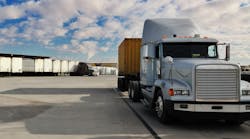Taking on a new role
How tires can influence the handling characteristics of medium- and heavy-duty highway trucks has traditionally been limited to maintenance issues. Proper inflation-pressure maintenance is often cited as most important.
Unlike passenger and light-duty truck tires, where an almost bewildering array of sizes, profiles and tread types is available, the variety of sizes and types of tires for larger trucks is relatively small.
New models are typically based on advances in materials, processing or design technology, and promoted as helping fleets reduce operating costs. Axle-specific tires have become popular for these reasons, but the tire selection process itself has remained fairly simple.
Several trends, especially in medium-duty trucks, may change the role tires play in truck handling. As more variations of Class 4 - 7 vehicles are offered, many vocational applications are reviewing their specs to avoid buying trucks that are any larger, heavier or more expensive than needed for the job at hand.
Manufacturers are adopting more car-like cab environments, steering and suspensions that improve ride comfort, and computer-matched components to keep drivers happy while containing the unnecessary costs that can result from over-spec'ing. In some cases, tire makers are responding to requests from truck designers to create smaller heavy-duty commercial tires tailored to particular chassis types and GVW ratings.
Overall, the concept of integrating tire and truck design at an early stage is a good thing. But fleets must be aware that tires of a given size and load range may not be as generically interchangeable now as they have been in the past.
Here are some basic tire/vehicle characteristics to keep in mind, especially when you're choosing tires for the newer, more efficient trucks.
-
Deeper tread depth tires tend to “feel” less stable laterally than comparable shallow tread tires. In extreme cases, stability complaints can result, especially on single drive axle units. It follows that worn tires sometimes feel more stable than new tires.
-
Lug type tires, which have large lateral grooves, sometimes tend to “feel” less stable laterally than solid circumferential rib tread designs. An intermediate design that puts traction elements in the center of the pattern, but has solid shoulder ribs, similar to the family of drive tires developed for tandem air-ride highway tractors, will normally fall somewhere in between.
-
Newer tire designs rely heavily on sophisticated rubber compounds to achieve good wear, fuel efficiency and handling. This makes it even more difficult to predict tire performance based on appearance or tread depth alone.
-
In some cases, new trucks may have a different track width than the truck being replaced. This can result in tires running outside the normal “ruts” or worn pavement sections of older roads, leading to driver complaints of “wandering” or excessive “sway.”
-
Lower profile (height/width ratio) tires tend to have more lateral stability than higher profile tires. This difference diminishes with higher inflation pressures, but can be a factor on tires that have a lower Load Range and inflation-pressure rating. Vocational trucks that are used in high center of gravity applications, such as utility service buckets, may benefit from these lower profile tires.
Adding new-generation vehicles to your fleet is more complex than ever. The best way to avoid tire spec'ing mistakes is to make sure you have the latest information out there.


